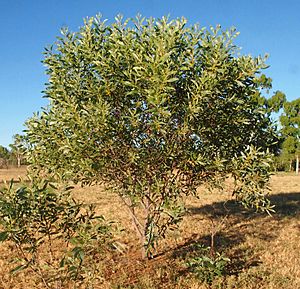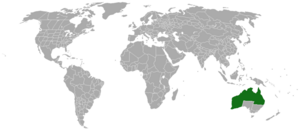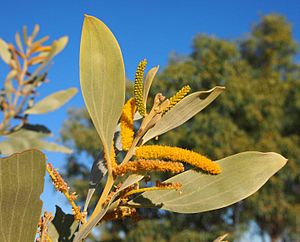Cole's wattle facts for kids
Quick facts for kids Cole's wattle |
|
|---|---|
 |
|
| Scientific classification | |
| Genus: |
Acacia
|
| Species: |
colei
|
 |
|
| Range of Acacia colei | |
| Synonyms | |
|
|
Acacia colei is a special kind of bush or tree. It grows naturally in northern Australia and parts of southern Asia. People often call it Cole's wattle. This plant has bright yellow flowers that bloom from May to September.
Contents
About Cole's Wattle
This plant usually grows as a bush, about 2 to 4 m (6 ft 7 in to 13 ft 1 in) (6 to 13 feet) tall. Sometimes, it can even grow into a tree up to 9 m (30 ft) (30 feet) high. Its new branches are covered in pale yellow-brown hairs. As they get older, these hairs turn a silvery color.
The leaves of Cole's wattle are called phyllodes. They are silvery-green to grey-green. These phyllodes are usually long and narrow, about 11 to 20 cm (4.3 to 7.9 in) (4 to 8 inches) long. They are also about 1 to 5.5 cm (0.39 to 2.17 in) (0.4 to 2.2 inches) wide. Each phyllode has a small, knob-like tip.
Flowers and Seeds
The bright golden flowers grow in spikes, which are about 3.5 to 6 cm (1.4 to 2.4 in) (1.4 to 2.4 inches) long. After the flowers, the plant grows seed pods. These pods can be curved or even twisted. They are about 3.5 to 4 mm (0.14 to 0.16 in) (0.14 to 0.16 inches) wide. Inside the pods are shiny brown or black seeds. These seeds are about 4 to 4.5 mm (0.16 to 0.18 in) (0.16 to 0.18 inches) long. They have a bright yellow part called an aril attached to them.
How Cole's Wattle Got Its Name
Two botanists, Bruce Maslin and L.A.J. Thomson, first officially described this plant in 1992. They wrote about it in a science journal. For a short time in 2003, it was called Racosperma colei. But in 2006, it was put back into the Acacia genus. This plant looks a lot like another species called Acacia holosericea. Because of this, people sometimes confuse the two.
There are two main types, or varieties, of Cole's wattle:
- Acacia colei var. colei, which is the common Cole's wattle.
- Acacia colei var. ileocarpa, also known as curly-podded Cole’s wattle.
Where Cole's Wattle Grows
You can find Cole's wattle all across northern Australia. It grows from the Pilbara and Kimberley areas in Western Australia. Its range extends east through the Tanami Desert and Great Sandy Deserts in the Northern Territory. It also reaches into the Simpson Desert and Gulf Country of western Queensland.
This plant is very good at living in dry, or arid, places. It can grow in many different habitats. These include rocky hills, sandy plains, and areas that sometimes flood. It grows well in stony, sandy, or clay-like soils.
Uses of Cole's Wattle
Cole's wattle is useful for several things. It helps with environmental management. It can also be used as food for animals (forage). The wood from the tree is also used.
The seeds of Cole's wattle taste good. They might even be a good food source for people in the future. Scientists did tests in Nigeria to see if this tree could be grown as a food crop in dry areas. The results were very positive!



